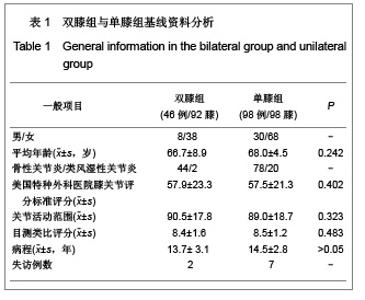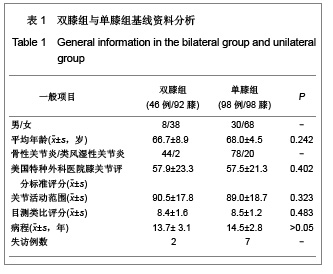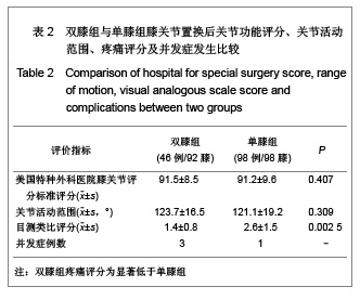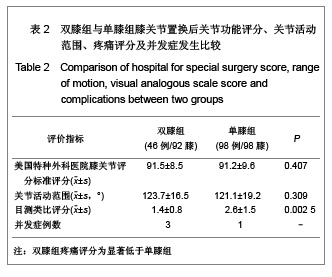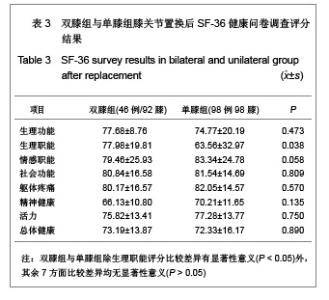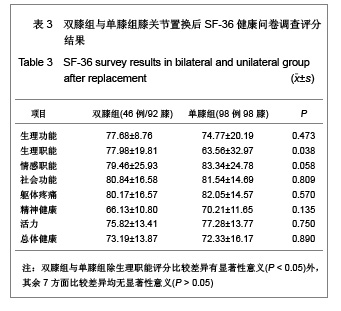| [1] Brotherton SL,Roberson JR,Fleming LL.Staged versus simulta neous bilateral total knee replacement. Arthroplaster.1986;1(2):221. [2] Lanc CJ, Hozack WJ, Shah S,et al.Simultaneous bilaleral versus unililateral tolal knee arthroplasly. Oulcomes analysis. Clin Orlhop.1997;(345):106-112.[3] Reuben JD,Meyers SJ,Cox DD,et al.cost comparison between bilateral simultaneous,staged,and unilateral total joint arthroplastv.J Anthroplasty.1998;13: 172-179.[4] Dorr LD,Udomkiat P, Szenohradszky J,et al.Intraoperative monitoring for safety of bilateral total knee replacement. Clin Orthop.2002;(396):142-151.[5] Reuben JD, Meyers SJ,Cox DD,et al.Cost comparison between bilateral simultaneous,staged,and unilateral total joint arthroplasty.J Anthroplasty.1998;13:172-179. [6] de Groot IB, Favejee MM, Reijman M, et al. The Dutch version of the knee injury and osteoarthritis outcome score: A val idation study. Health Qual Life Outcomes. 2008;6: 16.[7] Deirmengian CA, Lonner JH. What’s new in adult reconstructive knee surgery. J Bone Joint Surg (Am).2008; 90(11): 2556-2565.[8] Ahmed I, Gray AC, van der Linden M, et al. Range of flexion after pri-mary TKA: the effect of soft tissue release and implant design. Ortho-pedics.2009;32(11): 811.[9] Roos EM, Lohmander LS. The Knee injury and Osteoarthritis Out-come Score (KOOS): from joint injury to osteoarthritis. Health Qual Life Outcomes. 2003;3(1): 64.[10] Worland RL, Arredondon J,Angles F, at al. Thigh pain following tourniquet application in simultaneous bilateral total knee replacement arthroplasty.J- Arthroplasty.1997;12(8):848.[11] Xu JZ,Zhang XQ,Zhao JJ,et al.Zhengzhou Daxue Xuebao: Yixueban. 2006;41(5):957-959. 许建中,张晓强,赵甲军,等.一期手术治疗老年双膝骨性关节炎效果观察[J]. 郑州大学学报:医学版,2006,41(5):957-959.[12] Hu SP,Chen ZX.Fujian Yiyao Zazhi. 2010;32(4):28-29. 胡世平,陈祖星.全膝关节置换术治疗重度膝骨性关节炎38例[J]. 福建医药杂志,2010,32(4):28-29.[13] Roberts VI, Esler CN, Harper WM.A 15-year follovwup study of 4606 primary total knee replacetrtent J Bone Joint Surg Br. 2007; 89(11);1452-1456.[14] Elson DW, Brenkel U. A conservative approach is feasible in unexplained pain after Knee replacement: a selected cohort study. J Bone.joint Surg Br. 2007: 89(8):1042-1045.[15] Zeng JC,Sun JY,Yang LW, et al. Zhongguo Jiaoxing Waike Zazhi.2009;17(21):1609. 曾金才,孙俊英,杨立文,等.关节内置管局部浸润镇痛在全膝关节置换术的应用[J].中国矫形外科杂志, 2009,17(21):1609. |
